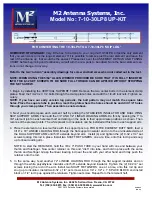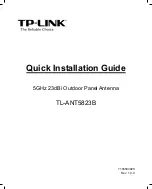
Page 9
Fine-tune the azimuth angle
. With the peaking meter still connected, fine-tune the azimuth
angle (see Figure 9). Ensure the three azimuth bolts are finger-tight. Using a 1/2” wrench, rotate the
azimuth fine-tune cam to adjust the azimuth angle to achieve maximum signal. After obtaining
maximum signal, tighten the three azimuth bolts labeled with a T3 to the recommended torque value
given in Table 1.
Do not torque the azimuth fine-tuning cam nut
.
Note
: You can adjust the azimuth angle three degrees in either direction using the azimuth fine-tune
cam. If the azimuth angle needs to be adjusted more than three degrees, loosen the mast bolts to
make the adjustment.
Figure 9. Fine tuning the azimuth angle
Fine-tune elevation angle
. Using the peaking meter, fine-tune the elevation angle. Using a
1/2” wrench, loosen the top elevation nut on the elevation rod to allow the satellite reflector to be
moved up and down in elevation. Move the bottom elevation nut along the elevation rod to adjust the
satellite reflector’s elevation angle and to achieve maximum signal. After obtaining maximum
signal, tighten the top elevation nut on the elevation rod, then tighten the elevation bolts labeled with
a T to the recommended torque value given in Table 1 (see Figure 10).
Figure 10. Fine tuning the elevation angle
Azimuth
Bolt
Azimuth
Bolt
Azimuth
Fine-tune
Cam
Do Not Tighten!
Azimuth
Bolt
(Not Shown)
Top
Elevation
Nut
Elevation
Bolt
Bottom
Elevation
Nut
Содержание D1000.4 EA
Страница 30: ...Notes...












































